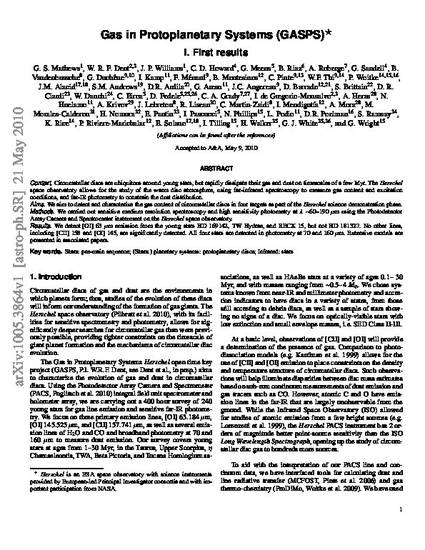
Context. Circumstellar discs are ubiquitous around young stars, but rapidly dissipate their gas and dust on timescales of a few Myr. The Herschel Space Observatory allows for the study of the warm disc atmosphere, using far-infrared spectroscopy to measure gas content and excitation conditions, and far-IR photometry to constrain the dust distribution. Aims. We aim to detect and characterize the gas content of circumstellar discs in four targets as part of the Herschel science demonstration phase. Methods. We carried out sensitive medium resolution spectroscopy and high sensitivity photometry at λ ∼60–190 μm using the Photodetector Array Camera and Spectrometer instrument on the Herschel Space Observatory. Results. We detect [OI] 63 μm emission from the young stars HD 169142, TW Hydrae, and RECX 15, but not HD 181327. No other lines, including [CII] 158 and [OI] 145, are significantly detected. All four stars are detected in photometry at 70 and 160 μm. Extensive models are presented in associated papers.

Additional authors: , D. R. Ciardi 23, W. Danchi 24, C. Eiroa5, D. Fedele 5,25,26, C. A. Grady 7,27, I. de Gregorio-Monsalvo 2,3 , A. Heras 28, N. Huelamo 11, A. Krivov 29, J. Lebreton 8, R. Liseau 30, C. Martin-Zaidi 8, I. Mendigut´ıa 12, A. Mora 28, M. Morales-Calderon 31 , H. Nomura 32, E. Pantin 33, I. Pascucci 5, N. Phillips 15, L. Podio 11, D.R. Poelman 16, S. Ramsay 34, K. Rice 14, P. Riviere-Marichalar 12 , E. Solano 17,18, I. Tilling 15, H. Walker 35, G. J. White 35,36, and G. Wright 15
This manuscript has been published in the journal Astronomy & Astrophysics. Please find the published version here (note that a subscription is necessary to access this version):
http://www.aanda.org/articles/aa/abs/2010/10/aa14595-10/aa14595-10.html
edp Sciences holds the copyright in this article.